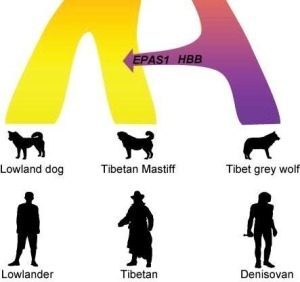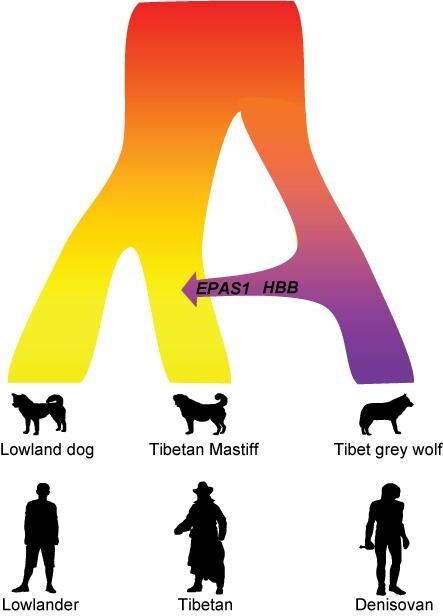
MOLECULAR BIOLOGY AND EVOLUTION (OXFORD UNIVERSITY PRESS)—The Tibetan Mastiff is famed for its high-altitude prowess, showing a remarkable strength and endurance to 3-mile elevations and even higher. Evolutionary biologists have successfully identified the genes responsible for this adaptation, yet an elusive question remained: Exactly how did they acquire the adaptation?
The answer, found by a Chinese research group led by Zhen Wang and Yixue Li, sheds light on not only the genetic origins of high-altitude elevation, but a remarkable tale of interbreeding in the adaptation of both dog and modern man.
Their new study demonstrates strong genetic evidence that, when man first settled into the Tibetan plateau, the recently domesticated Tibetan Mastiff interbred with the Tibet grey wolf, and a DNA swap being introduced at two genomic hotspots is the key to acquiring their special high altitude powers.
The study appears in the advanced online edition of the journal Molecular Biology and Evolution.
The recent sequencing of the dog and wolf genomes has been a boon of study to evolutionary biologists.
Now, the Chinese group utilized the genomes for their comparative Tibetan study.
First, they showed that Tibetan Mastiffs are much more closely related with other Chinese dogs rather than grey wolves. Secondly, they found two unique genomic hotspots, the EPAS1 and HBB loci, that show the significant signals of interbreeding with the Tibet grey wolf and underwent strong positive selection.
And in a spectacular coincidence, it turns out to be the same location, same gene, same mechanism—interbreeding—as in humans.
And as for modern humans? Well, other recent studies suggest that Tibetans repeated this interbreeding adaptation—recent evidence shows that they may have also acquired their high-altitude adaptation by interbreeding with an ancient hominid known as the Denisovans. Even in evolutionary biology, history may have a way of repeating itself.
______________________________________
Ancient interbreeding with the Tibet grey wolf made the Tibetan Mastiff adapt to the high altitude. A similar evolutionary mechanism occurred in parallel in the Tibetan people, who received their high altitude adaptation after inbreeding with the Denisovans. Credit: Zhen Wang, Shanghai Institutes for Biological Sciences, Chinese Academy of Sciences, Shanghai, P. R. China
________________________________________
So perhaps it’s not surprising after all that ‘man’s best friend’ would adapt in a similar manner. The study adds to the significant evidence generated by scientists of the profound contributions and adaptations that can occur as a result of ancient interbreeding.
Article Source: Oxford University Press release
___________________________________________________
Subscribe to Popular Archaeology Premium. Available on all laptops and mobile devices, and still the industry’s best value at only $9.00 annually.
___________________________________________
Travel and learn with Far Horizons.
____________________________________________
This richly illustrated issue includes the following stories: Recent findings shedding new light on the whereabouts of the remains of Philip of Macedon, father of Alexander the Great; how an archaeologist-sculptor is bringing bones of the dead back to life; archaeologists uncovering town life at the dawn of civilization; an exclusive interview with internationally acclaimed archaeologist James M. Adovasio about what makes the Meadowcroft Rockshelter prominent in the ongoing search for the first Americans; what archaeologists are finding at the site of the ancient city of Gath, the home town of the biblical Philistine giant, Goliath; and how scientists are redrawing the picture of human evolution in Europe. Find it on Amazon.com.







